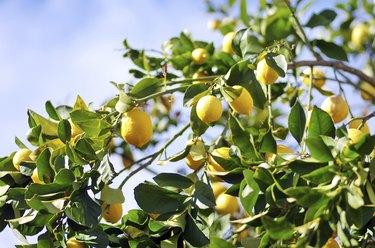
Freezing temperatures and cold winds threaten lemon trees (Citrus limon) in winter. In U.S. Department of Agriculture plant hardiness zones 9 through 11, lemon trees grow outdoors but need protection from unusually cold weather and snap frosts. In colder zones, growing compact lemon cultivars in containers outdoors in summer and indoors during winter is the best way to grow these trees. Untrimmed standard lemon trees grow 10 to 20 feet tall and 10 to 15 feet wide, depending on the variety.
Frosts and Freezes
Video of the Day
Lemon trees need protection from frosts and freezes during winter. Frosts occur overnight, often when the sky is clear. Temperatures dip below 20 degrees Fahrenheit for a few hours, and rise again. Freezes can last days or months in the coldest areas of the U.S. Lemon trees can survive light frosts with some protection, but are unlikely to survive freezes.
Video of the Day
Lemon trees suffer damage at temperatures below 25 F. In USDA zones 8 and below, lemon trees rarely survive outdoors year-round. Growing the trees next to walls in sunny areas sheltered from winds and on slopes, where cold air flows downhill, offer some protection from frosts.
Winter Care
Winter care for lemon trees involves protecting them from frosts. Watering the ground beneath the trees' canopies when frosts are forecast helps conserve heat. This works best if the ground is bare.
Other frost protection methods include covering small lemon trees with burlap, blankets, quilts or other materials. Remove the sheeting when the frost thaws the following day. Stringing holiday lights through the branches of larger trees also provides protection, or you can place an incandescent light in the canopy. Another option is to spray the tree canopy with water during the frost. This prevents the trees from freezing, but they must be constantly sprayed until the air temperature rises above 37 F.
Frost Damage
Frost-damaged lemon trees sometimes survive with good after care. Signs of frost damage include loose bark, split branches and dead leaves and twigs. The effects of the damage continue to appear for up to two years.
Wait until late spring or summer, when the lemon trees are producing new growth, before removing dead and damaged areas. These areas don't produce new leaves. Wipe the pruning shears with a cloth that was dipped in rubbing alcohol, before and after pruning lemon trees. Prune damaged areas 2 inches into healthy growth, and prune whole stems where they join the rest of the tree.
Use a pruning saw for larger branches. Sterilize the blade with rubbing alcohol, and saw the branches just beyond the raised "collar" where the branch joins the tree. Saw upward about 1 inch, and downward through the rest of the branch. Sterilize the pruning saw again when you've finished.
Lemon Trees in Containers
Lemon trees in containers grow well indoors in a bright room during winter. Containers for lemon trees must have drainage holes. Bring the trees indoors in early fall, and place them in an unheated but frost-free sun room or other well-lit area. Water the trees when the soil surface is dry, pouring water over the potting soil until it flows through the base of the containers. Place the trees outside in a sunny spot sheltered from wind when temperatures are consistently above 32 F in spring.
"Dwarf Lisbon" lemon trees (Citrus limon "Dwarf Lisbon") grow well in containers. Growing 8 to 12 feet tall and wide, or smaller in containers, these trees grow in USDA zones 9 through 10.